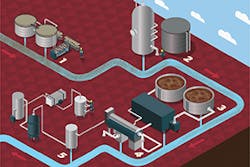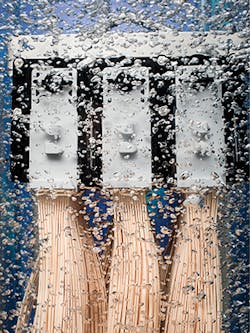How an Oil Refinery Recycles 100% of Its Wastewater for Steam Production
“Save water, save money” is the mantra of the City of Regina, Saskatchewan, Canada. It calls on consumers and businesses alike to be mindful of water scarcity issues while protecting, preserving, and carefully managing a precious natural resource. As one of the single largest fresh water consumers in the city, Federated Co-operatives Limited’s Co-op Refinery Complex (CRC) is embracing conservation with a $200 million environmental mega project focused on sustainability and environmental stewardship.
CRC is one of Canada’s largest and most productive refineries. Their mission is to fuel western Canada, but they are also committed to environmental sustainability. CRC operates on 800 acres of land in the northeast corner of Regina. Water is critical to the operations of the complex, which is why they are investing in this mega project, commonly referred to as the Wastewater Improvement Project.
This project utilizes new and innovative technology to clean and recycle wastewater. Once fully operational in mid-2017, CRC’s new system will clean more than 2 million gallons per day (mgd) of wastewater and reduce the refinery’s fresh water use by an amount that’s equivalent to the demand of 3,100 Regina households. It is a comprehensive and thoughtful plan that benefits the refinery, the environment, and the community.
The Wastewater Improvement Project is the culmination of the facility’s production expansion from 100,000 barrels per day (bpd) to 130,000 bpd, all while using less fresh water and discharging less wastewater. Guided by a strong commitment to safety, reliability, and sustainability, the company’s desire to expand has never trumped its innate obligation to preserve the Earth and its limited resources for future generations. Water is critical to the operations of the CRC, but by employing the latest of technologies, their water needs can be met in the most efficient of ways.
To execute a project of this magnitude, CRC partnered with GE Water & Process Technologies, a digital industrial company that has embraced CRC’s commitment and goals. GE has served the refining industry for more than 50 years, building dozens of unique solutions that drive innovative excellence and set the standard for water and wastewater processing.
AN INTEGRATED SOLUTION
The CRC draws water from onsite ground water wells, supplemented by the City of Regina’s municipal system during periods of high demand. An average of 1,600 gallons (7,000+ liters) of water per minute generates steam, which is used for heating, hydrogen production, and for powering equipment. Cooling towers also rely on water to control the temperature of refinery processes. The Water Security Agency of Canada tightly regulates water usage in the province and called on the CRC to find a new source of water to support the expansion.
With this requirement, the Wastewater Improvement Project was born, with GE developing a solution that combines ZeeWeed membrane bioreactor (MBR) technology and a high-efficiency reverse osmosis (HERO) system. Once fully operational, the CRC will recycle and reuse 2 mgd (7,571 m3/day) of wastewater, making it the only refinery in North America to recycle all of its wastewater for steam production. And as an added benefit, the new system will be closed so odor-causing organics will not impact the community around the plant as they have in the past.
Figure 1 shows a process flow diagram of the CRC’s Wastewater Improvement Project, a five-stage system that employs many of GE’s technologies.
During Stage 1, wastewater is delivered to holding tanks where gravity separates oil and water. Oil is skimmed off the top as it floats above the water and is reprocessed within the refinery. The wastewater is taken to another tank where sediment and oily sludge sink to the bottom. The oil is sent back to the refinery for reprocessing and the sludge is removed and disposed
of safely.
The remaining wastewater continues on to Stage 2, a dissolved gas flotation unit. Microscopic bubbles of nitrogen are pumped into the unit to bind to suspended oil particles. These particles are brought to the top of the unit where they are removed for reprocessing.
ultrafiltration membranes filter the wastewater
for reuse. Portrait taken at Oakville Ontario GE water filteration plant
After separation, the wastewater enters Stage 3, a biological treatment process to remove contaminants. Special bacteria break down biodegradable organic compounds and ammonia. This biodegraded solution is then filtered with GE’s ZeeWeed 500 ultrafiltration hollow-fiber membranes (see Figure 2). The coupling of the biodegradation process with GE’s ZeeWeed 500 is referred to as MBR, which is capable of removing suspended solids and decomposed organics from difficult-to-treat wastewater. The outcome is a clean, treated wastewater product called permeate. Figure 3 shows a comparison of untreated wastewater and permeate.
The permeate created during Stage 3 is largely free of organics, ammonia, and other impurities. It moves directly to the demineralization plant (Stage 5) for further treatment to prepare for steam production. The main function of Stage 4 is to handle the excess biomass from the bioreactor. This biomass is sent to a centrifuge to separate and return bacteria to the bioreactor. A small amount of water is extracted and reprocessed, while the leftover solid biomass is disposed of safely.
Stage 5—processing the MBR effluent through a demineralization plant—finalizes the recycled water for use throughout the refinery. The MBR effluent contains high levels of dissolved solids, such as salts, and therefore needs extra purification before it can be utilized for steam production.
wastewater (right)
The workhorse for this process is the HERO process, a technology for which GE has a license. This process consists of ion exchange units for hardness reduction, a decarbonator to remove alkalinity and carbon dioxide, and a specially designed reverse osmosis system. Employing hundreds of semipermeable spiral wound membranes, the reverse osmosis system removes dissolved solids like calcium, magnesium, chlorides, and sulfates. A second pass reverse osmosis unit polishes the water to an even higher purity standard, and a final pass through a mixed bed demineralization unit produces ultrapure water.
With its special pretreatment and design, the HERO system can run at greater than 90% recovery. Typical reverse osmosis operates at a substantially lower recovery, generating a higher volume of wastewater. The HERO’s uniqueness is its ability to effectively run at a very high recovery without fouling or frequent cleaning. Figure 4 shows the various HERO components.
CREATING A NEW STANDARD
The Wastewater Improvement Project will put the CRC on the map as the first and only refinery in North America that cleans and recycles all of its wastewater for the purpose of steam production. Water being utilized for steam generation must be of the highest quality. GE’s technology is helping CRC achieve that goal. The MBR system is currently operational and the HERO system will be operational by mid-2017.




